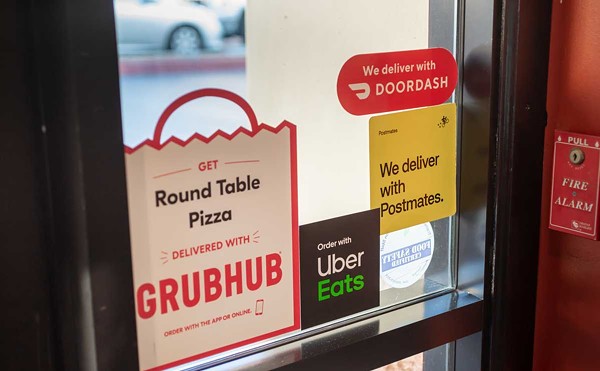In a time when old, brown salmon flesh magically turns ruby red for the retail display case, and one stray bit of infected cow brain or spinal column could turn our own brains into something resembling coarse peasant bread, the simple joy of eating is under tremendous strain.
I learned about one of the sneaky things currently amok in the fish and seafood industry in a recent New York Times piece. It was about just why we’re seeing all this eye-catching red salmon in even the least particular of food markets. Those who feed us salmon are hosing it down with carbon monoxide, that odorless, tasteless poison that sets off alarms in the basement when the furnace heat exchanger’s cracked.
The toxic gas, a component of wood smoke that adds the much-admired pink layer under the crust of properly smoked meat, does wonders with the looks of even a skank piece of salmon. It also pretties up perfectly fresh cuts of certain types of salmon that are simply not the bright, rosy hue of others. In food, as in fashion and TV news, good looks sell.
I don’t remember Mom once making salmon that didn’t come from a can — nice, bright red sockeye salmon that she combined with some egg, saltine crumbs and onion for her pan-fried “salmon patties,” also called “croquettes.” Using canned salmon wasn’t a bad thing at all; I have some in my cupboard now. It was wholesome, delicious, and I even liked the nuggets of processed fish vertebrae that had a slight crunch and were scattered through the salmon flesh like chocolate chips in a good cookie. Before you say “gack” and regard this as some kind of undiscriminating, undeveloped atavism, consider that preparing fish bones for consumption in many forms is a staple of refined Japanese cooking. I once watched a highly accomplished chef in Kyoto remove the broad skeleton of a flatfish, intact, through a tiny slit in its side, flash-fry it to a golden brown and insert it upright in the same slit of the finished fish as a lacy, edible garnish.
Mom died without warning two years and eight months ago, so our holidays are still raw, though we work assiduously to duplicate the traditional foods she always made for Thanksgiving and Christmas Eve. We’re not quite good enough. Even mashed potatoes aren’t the same as when they were made by her, standing at the sink and putting up with catcalls and rhythmic clapping from her family of smartasses when energetic mashing got her backfield in motion. But we give it all a good shot.
She was a wonderful, simple home cook who set out meal after meal based on the old nutritional food pyramid. There was never a word about portion control, cholesterol, sodium, carbs, trans fats, antioxidants, unrefined sugar or flour, free-range anything, organic baby vegetables, the geopolitical implications of eating certain foods, or any of the other never-ending considerations faced by diners today — although she did regularly remind us to get plenty of vitamin C, because Linus Pauling said it helped fight the common cold. None of us grew up fat, sickly, stupid or otherwise challenged by our diet.
It’s a sad irony that in a time when the variety of foods available to us is unprecedented, we have to think so hard while eating it. We’ve been conditioned for paranoia about every bite we eat (although not enough to prevent this country, with Detroit at the forefront, from becoming the most obese on the planet).
As a food writer, I suppose I have some moral obligation to promote healthy choices, careful nutrition, sustainable products and the rest. But today, I just can’t. So much of how we regard food today is nonsensical — toxin-treated salmon and Taco Bell notwithstanding.
One reason Julia Child was so dearly loved by her public was the eminently sensible, time-tested approach she took to eating. All things in moderation, she said over and over, while fad shortcut diets came and went and overindulgence was rarely admitted as a cause of poor health. There’s no substitute for butter, she said, just don’t be a pig about it. The same went for nearly everything she taught us to cook.
So this week I offer you a dish that breaks all the current rules, one that many, many World War II soldiers had grown to love in the service and wanted to have when they came home. It’s one that’ll give the carb cops and other fanatics a case of the vapors. There are few better midnight snacks; just don’t eat it all the time. And while I don’t know if Julia ever made the stuff, this is just the way Mom used to do it.
Creamed Chipped Beef on Toast
(or “Shit on a Shingle”)
There are too few ingredients to bother listing them.
Simply make a white roux by whisking together equal amounts of flour and melted butter — 2 or 3 tablespoons of each will do — over medium heat for a few minutes until the flour loses its raw aroma and taste.
Slowly add 1-1/2 to 2 cups of warm whole milk, continuing to whisk until the white sauce is smooth and the consistency of heavy cream.
“Unfurl” dried beef from an 8-ounce jar, rinse off some of the salt and pat dry on paper towels. Stir into the cream sauce and heat through.
Season with a little sweet paprika, cayenne or black pepper, if you like, and serve over torn pieces of toasted crusty bread (buttered, if you want to go all the way).
Ric Bohy is the editor of Metro Times. Send comments to [email protected]




